Sustainable Business Innovation
Congrats - Sustainability is the buzzword of the decade. BUT we want to stop the bullshit and get to the heart of the most important sustainability concepts. To do so, let us break down the big word into its essential parts and look at why business models play such an important role in turning sustainability ambitions into reality.

Dominik Kaiser
Sustainability Expert
Danny Locher
Business Design Coach
Content
1. Sustainability and Business Design... Why?
Sustainability and Business Design sounds like an unnecessary extension. Isn't innovation driving sustainability anyway and haven't we done enough to electrify our company fleet and stopped printing our emails?
Well, aiming to seriously consider sustainability as one of the objectives to measure good, future-oriented innovation is much more complex than that. Sustainability isn't a one-dimensional measurement rather than a continuum of balanced efforts across social, ecological and economic objectives. The lack of simple answers (and measurements) opens the door for all kinds of pseudo-solutions, which in some cases are even hard to be identified as such.
To get some grip on this and start to seriously look at sustainability drivers for your innovation it is essential to understand the key principles behind sustainability, discuss good and bad examples of sustainable business transformation in action and learn about how the business model-driven approach to sustainability offers a powerful framework for companies to align their economic objectives with environmental and social responsibilities.
It's absurd to consider sustainability a liability rather a value driver. If a Business Model defines the way how you operate your business and generate value, the levers that help you to realize your sustainability objectives need to become a core part of the mechanism that makes your Business Model work.
And that's not just our opinion. A recently study published by the Harvard Business Review highlights the significance for companies fostering their sustainability efforts. In the study with more than 100 enterprises, many of these companies have developed a sustainable competitive advantage in the long term by gradually developing innovative and sustainable business models (Harvard Business Review 2022).
Let's establish a basic common understanding and get to work!
2. Triangle of Sustainability
The sustainability approach in companies is defined as the "Triple Bottom Line" or "triangle of sustainablity," which means the lasting balance between a company's economic, environmental, and social responsibilities.
Economic growth should not come at the expense of the environment and social responsibility.
Economic responsibility refers to the ability of a company to be economically successful while simultaneously saving resources and reducing costs.
Ecological responsibility is the commitment of the company to minimize its impact on the environment and implement sustainable practices in the management of resources and waste.
Social responsibility is the commitment of the company to consider social and ethical requirements in its business practices, such as ensuring fair working conditions and protecting human rights.
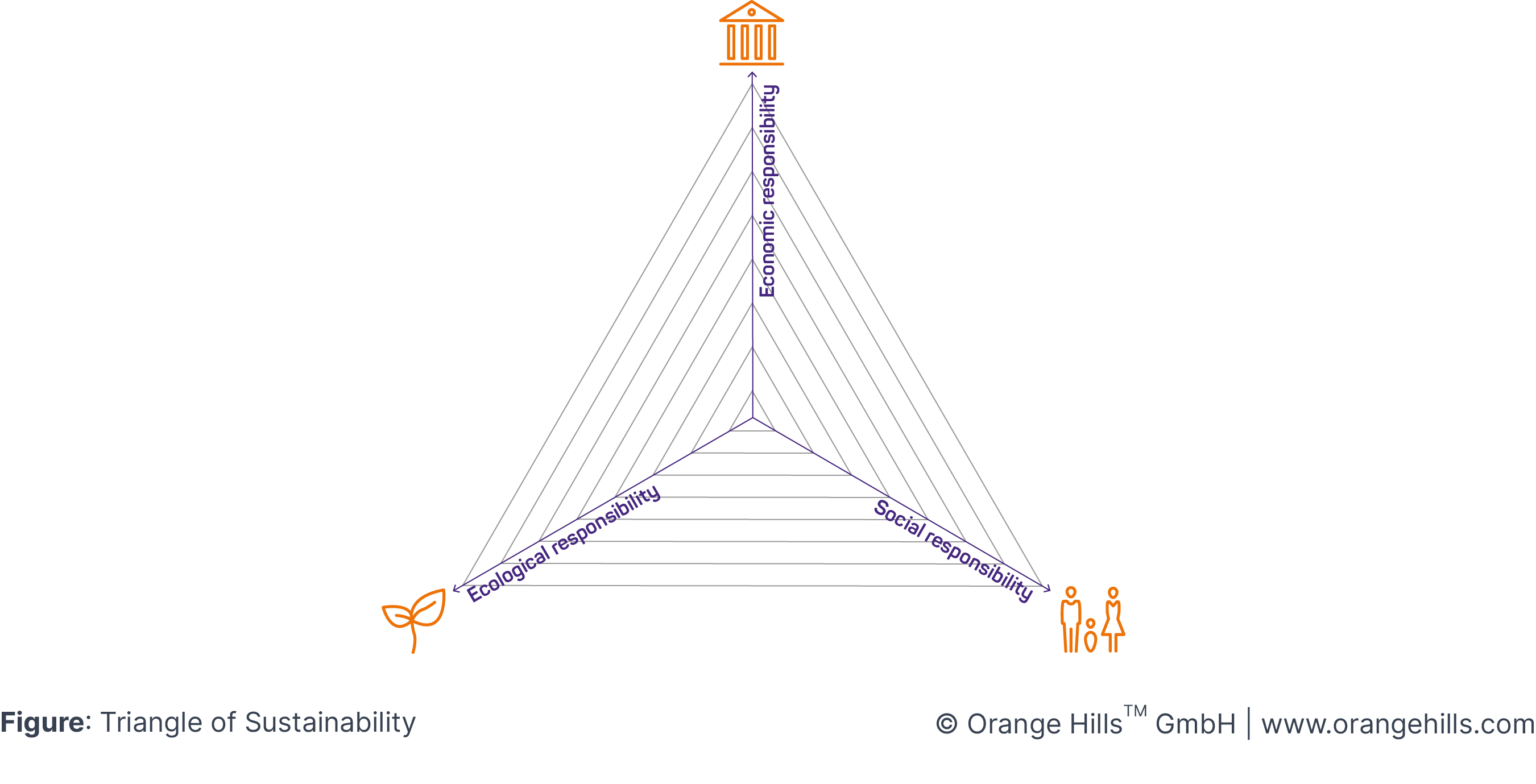
By integrating these three pillars, companies can work towards sustainability, making positive contributions to the planet, society, and their long-term success. Embracing sustainability in all aspects of business is essential for creating a more sustainable and equitable world.
3. Sustainability mindset
The sustainability mindset encompasses a range of archetypes, each representing a unique perspective and approach towards sustainability. Spanning a coordination system, these archetypes reflect both the level of action individuals take, ranging from doing nothing to actively engaging, and the attitude they adopt, ranging from negative skepticism to positive enthusiasm. By understanding these diverse mindsets, we can cultivate a more comprehensive understanding of sustainability. First we examine the attitude of the archetypes:
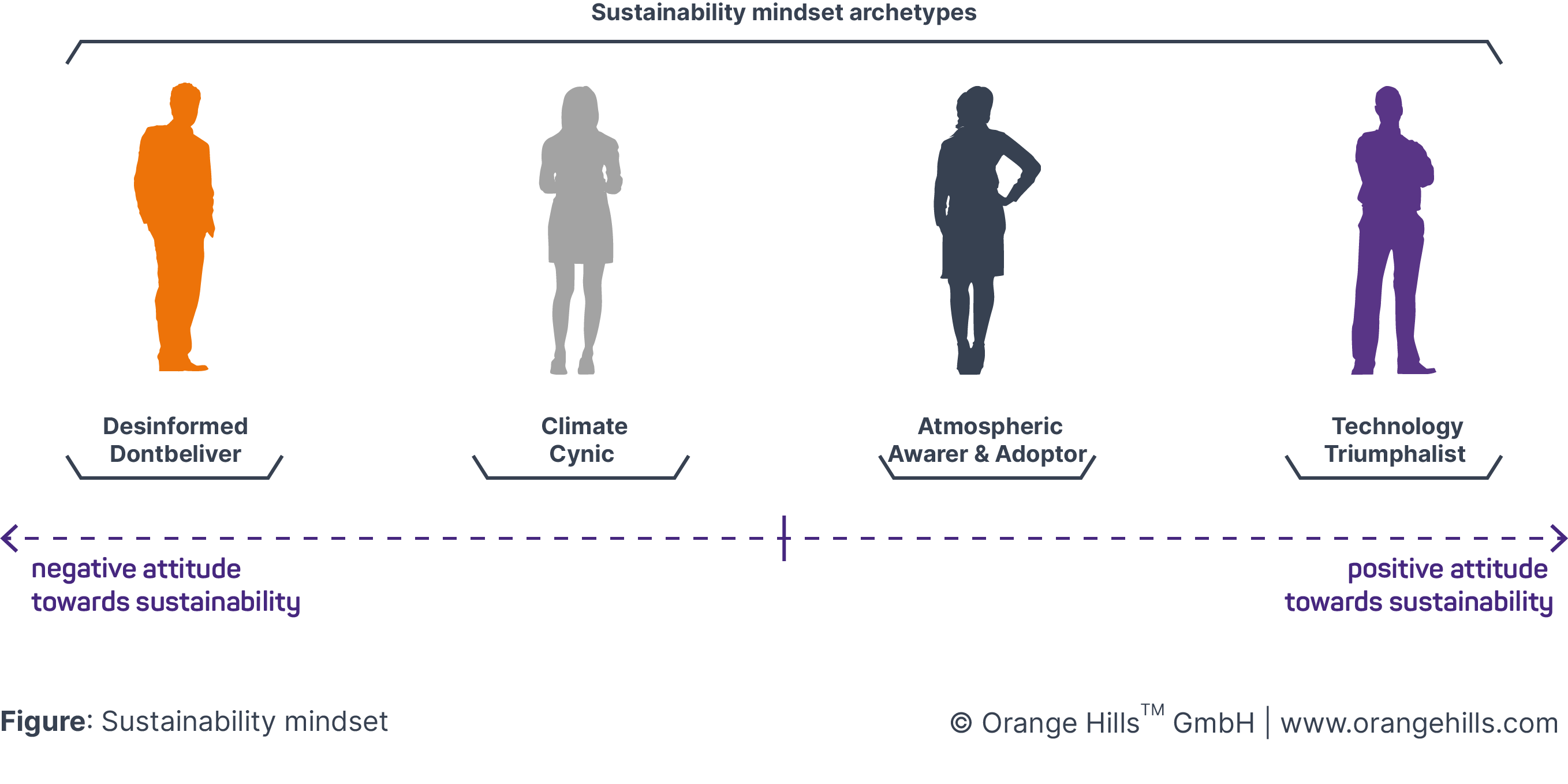
Desinformed Dontbeliver
Thinks:
Nothing - No words needed, we think this one is out of our range but if not, please try to have a fruitful discussion with Donald Trump.
Does:
Nothing
Says:
„There is no evidence for a human-caused climate change“
Climate Cynic
Thinks:
Climate change is already inevitable and their consequences
Does:
Nothing, because in their opinion human efforts/ mitigation actions do not have an positive impact and cannot stop the changed world
Says:
„Its already too late – we are lost“
Atmospheric Awarer & Adoptor
Thinks:
Climate change and its impacts are already there
Does:
A lot and takes personal/ company actions to steer against the trend while trying to minimize vulnerability and ableness to cope with climate-related challenges
Says:
„ We are sitting already in the sinking boat and we have to reinforce the walls but we can probably achieve a turnaround“
Technology Triumphalist
Thinks:
Real life consequences of the climate change and its impact are already there but not to hard
Does:
Allocation of (financial) resources into research and development to find technological solutions for all climate-related challenges
Says:
„Technology will save us“
Second we have a closer look on the action radius of these archetypes:
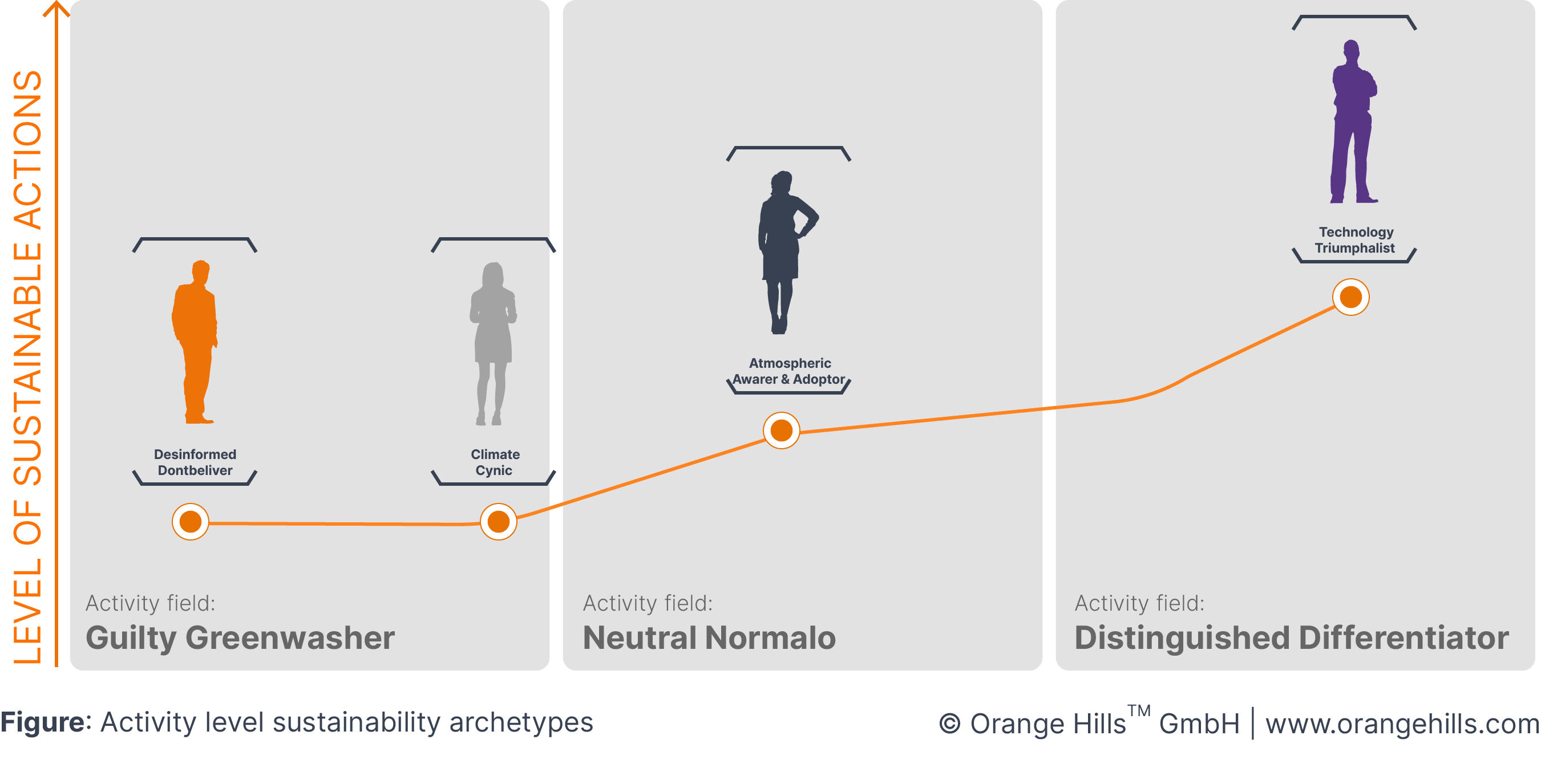
Guilty Greenwasher
Thinks:
Sustainability is a great marketing vehicle
Does:
Nothing - to few actions (or even worse only actions with low impact but with high visibility)
Says:
„We are the most sustainable company in the world because…“
Neutral Normalo
Thinks:
Sustainability is such a big topic, but we are quit unsure where and when to start...
Does:
Acts within a very manageable radius of action
Says:
„We are just overwhelmed and not sure where to start, but sometimes it is better to do nothing before recieving a full-grown shitstorm“
Distinguished Differentiator & Atmospheric Activist
Thinks:
There have to be more awareness and more action
Does:
Acts and sometimes lobbys and protests for more actions
Says:
„Stop the blablabla – we need to act!“
4. Sustainble business models in action
After explaining some theory, we want to highlight some sustainable business models in action, which we really like and which we don’t.
Starting with the focus on the ecologicial pillar of our triangle: In 2022 Continental announced that they are as well very deep into sustainability and even further into Circular Economy. "We are producing tyres out of polyester of recycled PET bottles" were communicated in a press release. So far so good and on first sight, it sounds good. BUT this case is not an upcycling (a process of creative reuse and transformation of discarded or old materials into products of higher value or quality) case, even worse it is a perfect downcycling example (is a recycling process where materials are transformed into products of lower quality or value compared to the original material).
This is not upcycling, this is downcycling!
PET bottles are the perfect representation of a well-functioning recycling loop, where the purity of the material is upheld in accordance with high hygienic standards. But what happens now, they are downcycled into disposable tires that will most likely be burned. The downcycling of PET into tires removes crucial material from the bottle-to-bottle recycling loop, and this occurs on a large scale. In our perspective, it accurately portrays the characteristics of the archetype of a "Guilty Greenwasher."
Within the sustainability triangle, the emphasis is largely on economic aspects and the demonstration of social responsibility, with somewhat very limited or even negative ecological impact.
But at least after some public criticism the Continental announced to refine their process e.g., only using PET bottles out of non-closed loops.
On the other hand, a very positive example is the family-owned German outdoor brand VAUDE.
VAUDE has made environmentally friendly and fair business practices its core mission, consistently working for over a decade to transform the company holistically and systematically.
Some exemplary initiatives: They established the VAUDE academy, where they share their approaches and ideas for transforming to a sustainable company for free. As well VAUDE is very closely monitoring his supply chain and commits his suppliers to sustainability. A very impactful initiative is currently on its way which describes upcycling. In cooperation with BASF VAUDE is manufacturing out of two old not more usable work clothes a new day pack.
For us, VAUDE exemplifies a "Distinguished Differentiator," seamlessly embodying this role within the sustainability triangle at a high level. They showcase economic success and growth, concurrently contribute to society, and demonstrate a strong dedication to ecological responsibility.
Closing our loop with a 100% circular business model is the sub brand CyclonTM of the brand On.
CyclonTM offers circular products made from a single material (coffee beans), creating running shoes and shirts.
Due to the use of a single material that is easily separable, the product remains entirely within the circular economy. Particularly interesting from an economic perspective is that the shoe is exclusively available through a subscription model. Subscribers become members of an exclusive club, receiving regular shoe replacements. Comparatively, a standard running shoe for the average runner costs around €150-€180 and lasts approximately one year. In the On business model, subscribers have the option (not mandatory) to receive a new shoe after six months (regular period as well ~12 month), with a renting fee per month for 30€.
We see this as a very smart and sustainable business model, resulting in a robust presence across both economic and ecological dimensions within the sustainability triangle.
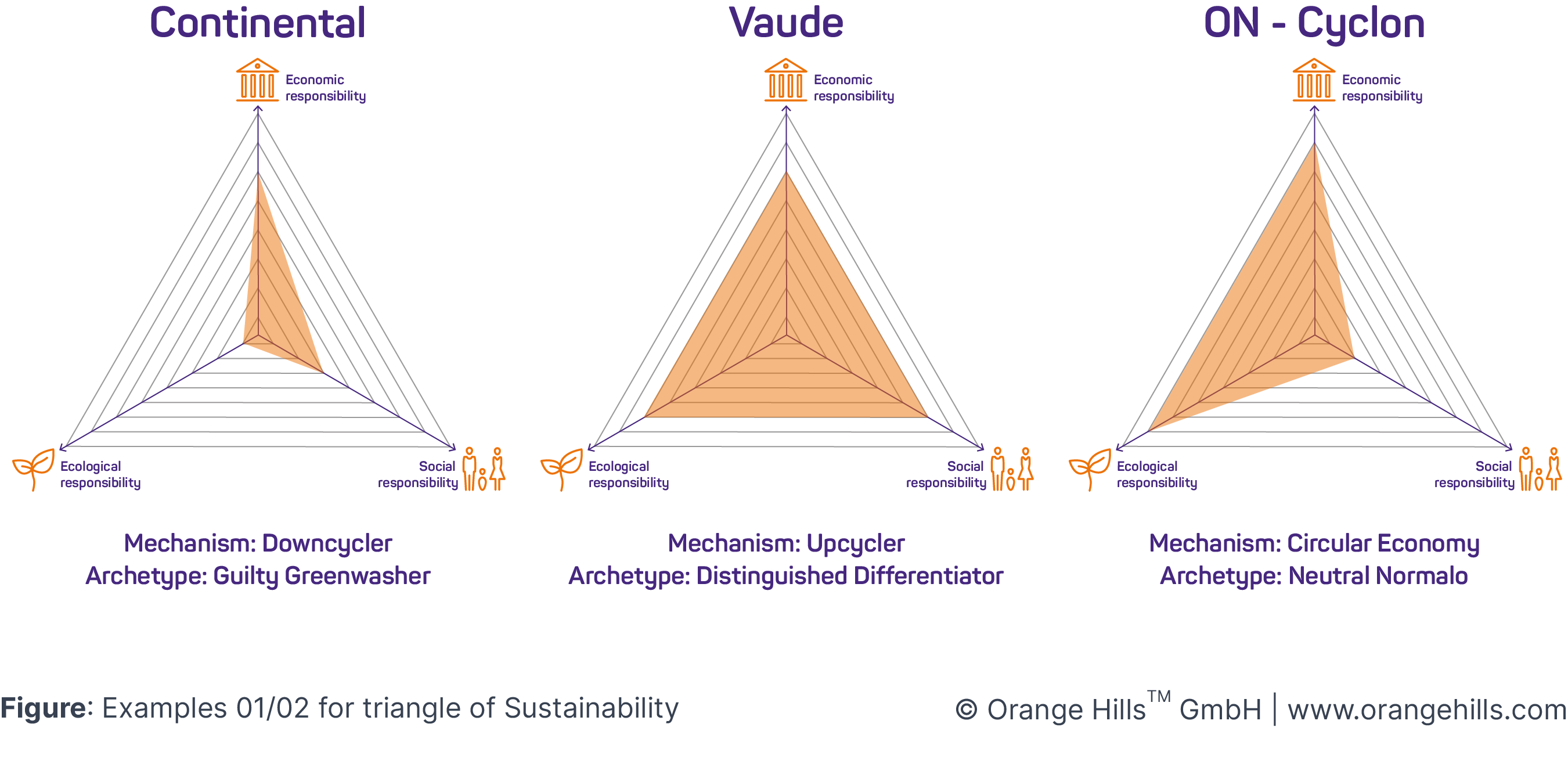
Shifting away from the circular economy, let's focus on other companies that have a positive impact. Edding, a publicly traded medium-sized company, initially focused on distributing markers but has transformed its business model multiple times and experimenting a lot with new business fields.
Edding has transitioned from a profit-oriented company to a purpose-oriented company with environmental and social sustainability at its core.
The strategic transformation by 2026 emphasizes a commitment to a purpose-driven approach, exemplified by collaboration with SHARE. The true meaning and evolution of this model will be revealed in the future, underscoring our classification as a "Neutral Normalo." Nevertheless, our outlook is optimistic.
This representation in the sustainability triangle reflects a balanced level of ecological and economic considerations, with a notable emphasis on and amplitude for social responsibility.
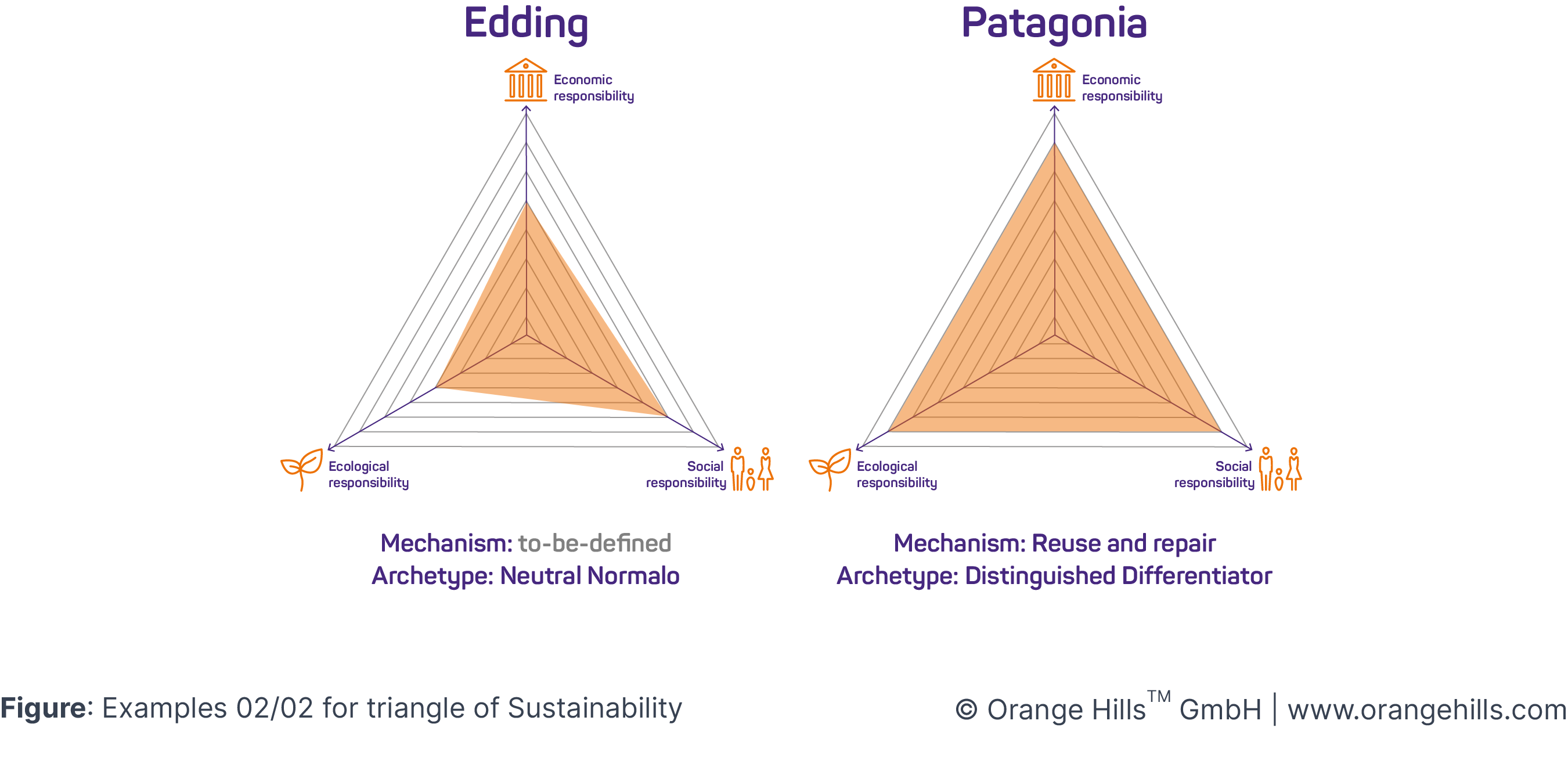
Another notable example is Patagonia, consistently recognized as one of the most sustainable companies.
If you were to Google for "a sustainability forerunner", Patagonia would undoubtedly be on of top ranks.
Initially, we hesitated to include such an obvious example, but given Patagonia's role as a sustainability role model as a “Distinguished Differentiator”, we decided to highlight two remarkable and exceptional aspects:
First and foremost, they proactively addressed controversies in their supply chain, such as the mistreatment of geese for down and unethical practices in the Merino wool supply chain approximately 15 years ago. Patagonia's quick response, transparency, and dedication to resolving issues showcase exceptional trust and honesty.
Patagonia's authenticity is evident in the alignment between their words and actions. There is minimal facade, and they promptly address issues upon identification. This level of trust, honesty, transparency, and a willingness to forego profit margins is exceptional.
Secondly, what makes Patagonia remarkable is not only its commitment to addressing social and environmental concerns but also its ability to achieve growth and value while remaining responsible for the planet and its people, surpassing market expectations.
This leads us to highlight Patagonia as a best practice model across all three facets of the sustainability triangle.
We hope our exploration of sustainability initiatives provides inspiration for what can be achieved with genuine commitment and action.
5. Sustainability into context
Ask Chat GPT about the three main concepts around Sustainability and they say SDG, ESG and planetary boundaries…we described already the triangle of sustainability and now we will put all these concept into context.
1. SDG
SDG is the abbreviation for Sustainable Development Goals. These are a set of 17 global goals established in 2015 by the United Nations to address until 2030 the „most important“ social, economic, and environmental challenges facing the current world. These goals cover a wide range of areas: from mitigation of poverty, education, healths, gender equality, climate action, clean energy to responsible consumption The SDGs provide a broad framework for countries, organizations, and individuals to work towards a more sustainable future.
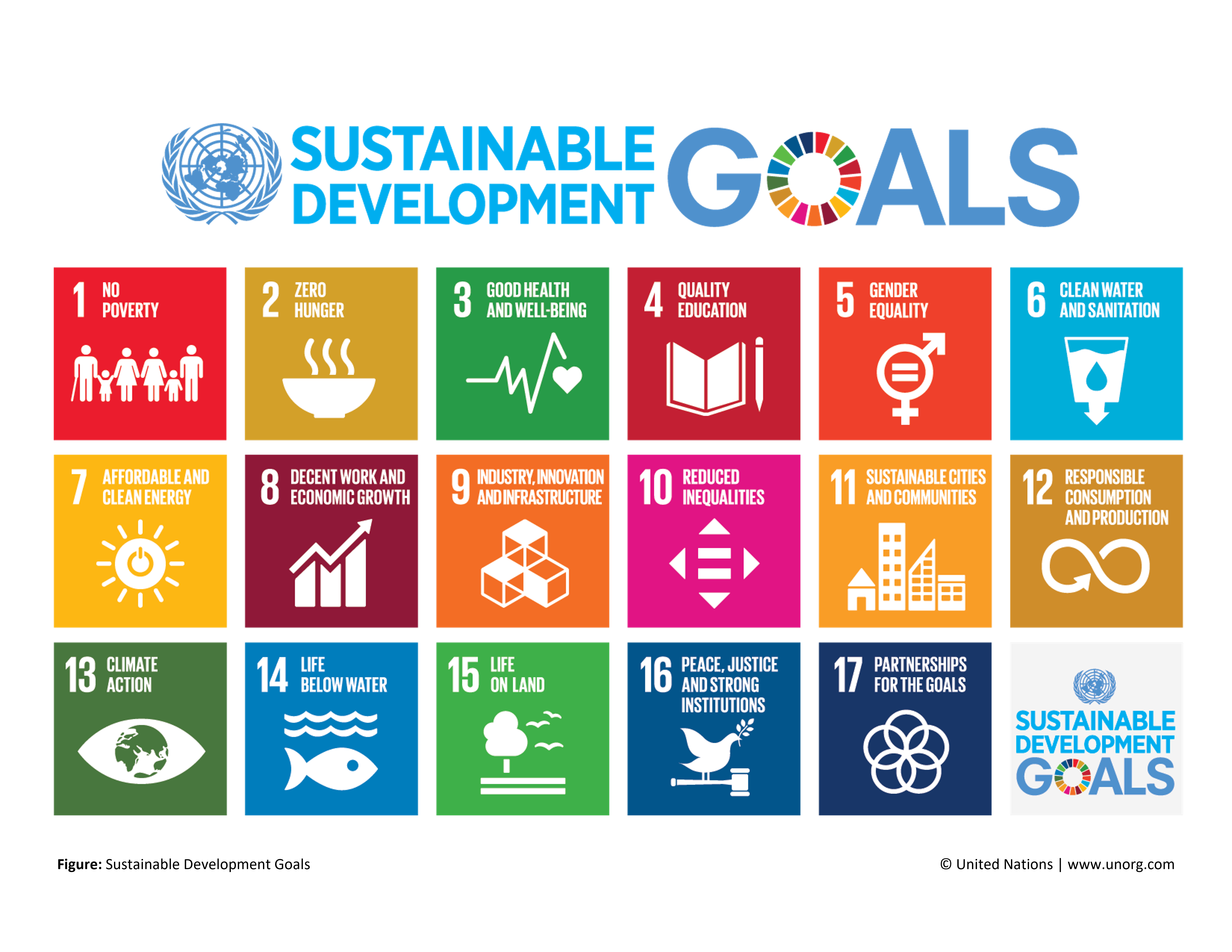
2. ESG
ESG stands for Environmental, Social, and Governance. ESG, at its core, is a corporate governance and investment framework. What this means in practice is companies that adopt ESG principles consider, measure, report the environmental, social, and governance aspects of their business alongside its financial considerations (profit, expenses, growth, accounting.
It is a framework used to evaluate a company's performance and practices in these three areas.
Environmental factors assess how a company impacts the natural environment, such as its carbon emissions, waste management or resource usage. Social factors evaluate how a company interacts with its employees, customers, communities, and other stakeholders. Governance factors examine the company's internal controls, leadership structure, and ethical standards.
ESG considerations can be aligned with the SDGs by incorporating them into business practices and strategies to contribute to the achievement of these goals.
The ESG factors align with specific aspects of the SDGs, e.g.:
Environmental factors in ESG, such as reducing carbon emissions or promoting sustainable resource management, are connected to SDG 7 (Affordable and Clean Energy) and SDG 13 (Climate Action).
Social factors in ESG, like ensuring fair labor practices or supporting community development, relate to SDG 1 (No Poverty), SDG 3 (Good Health and Well-being), SDG 8 (Decent Work and Economic Growth), and SDG 10 (Reduced Inequalities), among others.
Governance factors in ESG, such as transparent reporting or ethical business practices, contribute to SDG 16 (Peace, Justice, and Strong Institutions).
By considering ESG factors, companies can assess their performance in relation to specific SDGs and work towards aligning their practices with the broader sustainable development agenda. Thus, the ESG framework can be derived from and connected to the SDGs, providing a more focused lens to evaluate sustainability practices within a business context.
3. Planetary boundaries
Planetary boundaries defining the limits within which earths systems can operate safely to support human civilization. These boundaries were developed by scientists and can be used as thresholds beyond which environmental cahnges may have catastrophic consequences.
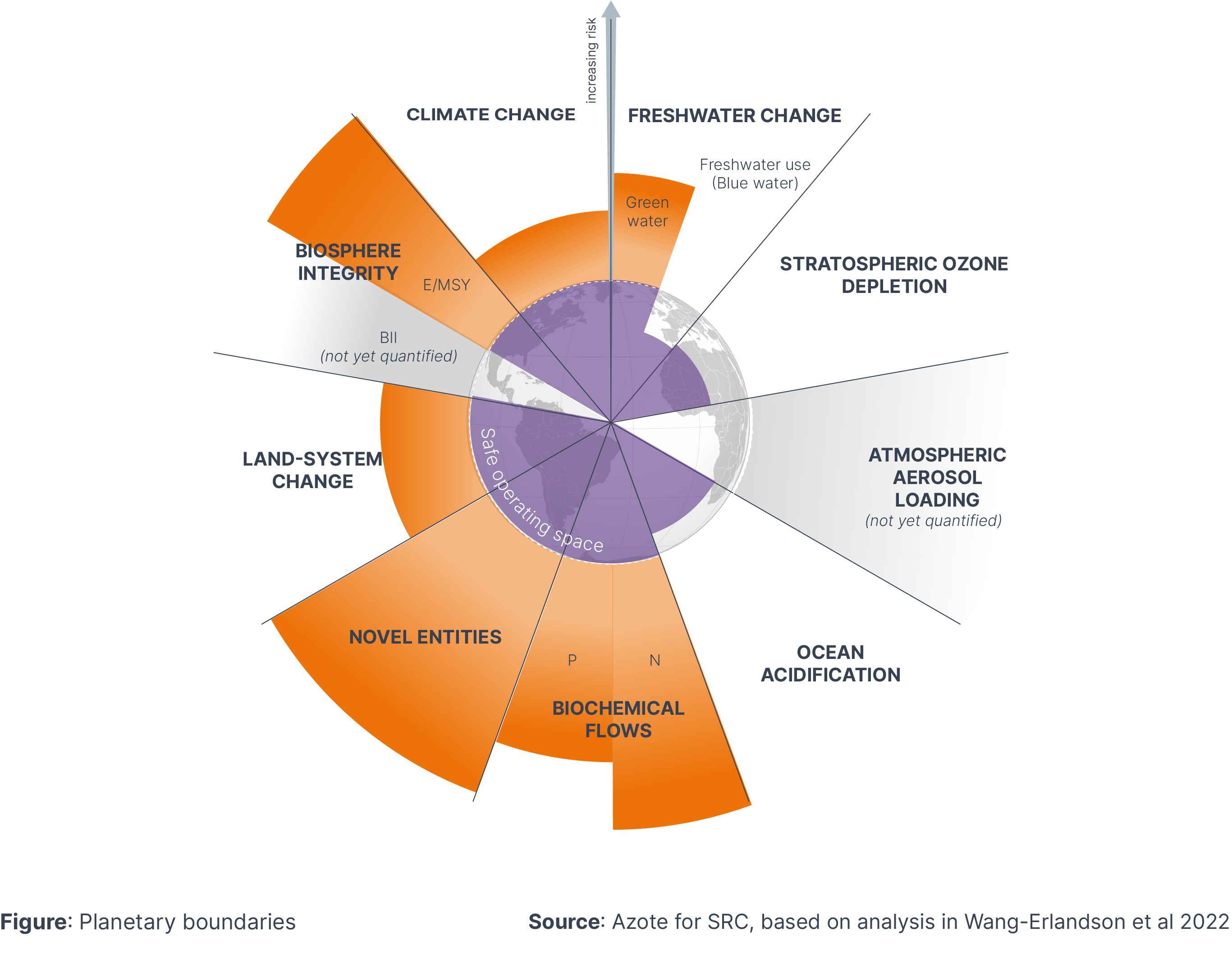
These boundaries are e.g. climate change, biodiversity loss and fresh water use. By respecting this boundaries, we could maintain a stable and sustainable planet for future organizations.
To put in a nutshell, these three concepts setting goals on global level, giving companies a framework and showing the limit of the planet.
All concepts addresses the need for sustainable development, responsible corporate practices, and the preservation of Earth's ecological balance. By promoting responsible actions and policies at the global, corporate, and individual levels, they contribute to building a more sustainable and equitable future for all.
6. Getting started
The next steps will take you from theory into practice, leveraging this basic understanding of sustainability in your Business Design efforts. We will incrementally extend the sustainability related tools and methods for Business Design over the next months. So far, you will find first sustainability related elements as part of many of the Business Design phases and activities, such as sustainability focused discover questions, etc.
You want to get started and set a baseline where you stand in terms of sustainability? Here are some simple, initial activities that you can incorporate for yourself or your Business Design team to kick it off.
Activity-1: Commitment towards the UN SDG's
Outside perspective - What do we currently communicate about the [company's / division's / team's] position towards sustainability? How do we position towards the UN SDG's and what do we report on in our company ESG report?
Activity-2: Triangle of Sustainability
Discover the status-quo - How do we currently score at the three dimensions as a [company / division / business area]? How do direct competitors score? What do they actually do?
Understand future ambitions - How do we aim to score at the three dimensions as a [company / division / business area] in the future, according to our documented ambitions?
Contribution of innovation - How does our innovation project would need to contribute to the achievement of our documented ambitions? What are the consequences?
Activity-3: Sustainability Mindset and Archetypes
Yourself - With which archetype could you sympathize? Do you recognize differences for your own behavior changing for certain areas of your life / work-life or activity?
Your team - Which archetypes are you dealing with in your team? Does the understanding of the value of sustainability already starts in your team or can you join forces with other pro-sustainability minds?
The company in the market place - How does the market perceive your company's efforts? Trying to fight a public perception of "guilty greenwasher" will be a completely different game than adding to the merits of a company already seen as distinguished activist.
